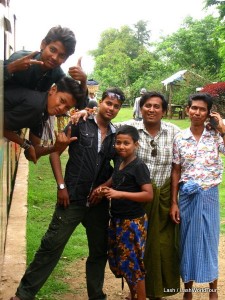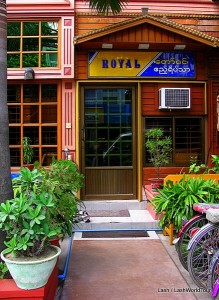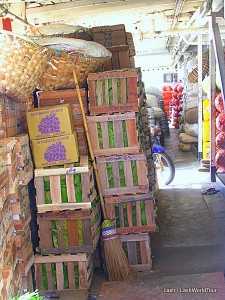Travel Tips: Downsides of Visiting Myanmar
Myanmar is a noticeably more tiring and difficult country to travel through than most of its neighboring SE Asian countries. Most of the issues are due to poor infrastructure. Myanmar is just catching up to the modern world, and albeit quite rapidly, it still suffers from many difficulties of a yet-to-develop country.
Other major downsides are the gouging of tourists on prices and poor value for money on guest houses and some forms of transportation. Now that Myanmar has opened its doors and tourists are suddenly flooding in, the government and many locals have decided to cash in by instantly doubling or tripling prices for tourists, specifically on rooms and transportation services.
Following are the blow-by-blow details, which I’ve categorized into Difficulties, Gouging of Tourists and Poor Value for Money.
Difficulties
Long and tiring Transportation
* Roads are mostly in poor to terrible condition, which makes for very bumpy, long rides.
* Bus departure times are often at very difficult and inconvenient times: 5.30 am the only available bus or night time only service available. Such departure times can seriously screw up sleep schedules and make food difficult to come by.
* Travel times are often exceedingly long. Even if distances aren’t that far, buses, trains and boats still take a seriously long time to reach their destinations, much longer than they do in neighboring countries.
* Cargo. One major reason bus, train and boat times are so extremely long is that they serve as cargo service as well as passenger transportation. They often stop to load on or unload cargo, sometimes lots and lots of cargo. This can easily add anywhere from an extra 30 minutes to several hours to the travel time.
In addition, the excess cargo also usually makes the journey quite uncomfortable since the cargo often takes up all the leg room and/or blocks the scenic views. Besides that, too many people are usually crammed into the remaining space not taken up by cargo.
The Ayerarwady River slow boats are the worst in this regard. Loading and unloading cargo at selected stops along the way adds several hours per day to an already very long journey.
* Trains are strangely also very bumpy, sometimes bouncing up & down like a trampoline and swaying back & forth like a ship on a rough sea. Trains also run considerably slower than buses, with frequent delays of 1 – 2 – 5 hours on a day trip.
Bottom line: overland travel in Myanmar is generally very inconvenient, slow, bumpy, uncomfortable and tiring. For me, this was the most difficult and tiring aspect of visiting Myanmar. It would be a great idea to minimize your overland travel during your trip, which would make a much less tiring and uncomfortable experience.
* Note: An exception are the ‘express’ buses that run between Yangon and Mandalay. They truly are luxury buses, more like riding in an airplane. They feature luxurious reclining seats, blankets & pillows, free water and boxes of snacks, movies & music and air conditioning.
They make overland travel much more comfortable and also cut the journey from 12 hours to 8 or 9 hours. However, the poor road conditions still make for a bumpy ride. At least they are softly bumpy instead of bone-jarring bumpy.
Noise
Nowadays, mainly due to so much roaring traffic, Myanmar is quite a noisy place. Even small, supposedly quaint towns are roaring with motorbike traffic. People in rural towns also tend to talk very loudly.
This was my pet-peeve during my recent 2013 trip through Myanmar. Back in 2000 Myanmar was immensely quiet, primarily due to a serious lack of motorized traffic. See my post: Myanmar Then & Now
Frequent power cuts
Guess what goes off when the power is cut? Lights of course. But consider a bit further: off go the fans, air conditioning, hot showers, refrigerators, internet connections, computers. Could be mighty uncomfortable if you’re trying to sleep or relax in 35-40C temperatures without even a fan.
Could be mighty inconvenient if you’re in the middle of a shower, especially at night time. Could be quite disappointing or even slightly dangerous if you were trying to chill a drink or food in the guest house fridge. Could cause some serious website problems if you’re unexpectedly cut off while inside your accounts, uploading photos or in the middle of work.
Power cuts happen everywhere, even in Myanmar’s main cities. And they happen nearly every day, several times per day.
Fortunately, most businesses, including guest houses and hotels, have generators as back up power, since power cuts are a part of daily life in Myanmar. Power often returns quickly as staff kick on their generators. However, guest houses, hotels & shops might very well not turn their generators on during the daytime, saving energy and fuel until absolutely needed at night.
So power cuts could be a slight inconvenience or a major hassle, depending on luck and circumstances.
Very few local people speak English
Travelers who stick to the primary tourist destinations, guest houses, hotels, restaurants and attractions will be interacting with lots of Burmese people who speak passable to excellent English. Language barrier won’t be an issue.
But anyone who strays just a bit off the main spots is going to have to communicate with locals who don’t understand English. If you venture into any local tea shops, food stalls, restaurants or wander out into the countryside or markets, you’ll immediately discover that most people can’t speak English or understand you.
Then again, you’ll be surprised how often some local person unexpectedly pops up speaking enough English to help you out or answer your questions.
However, even if no local English speaker appears, it’s really not difficult at all to get people to understand you, with just a little ingenuity. Use hand gestures, point, figure out a way to get your point across. And if you learn a few basic Burmese phrases like ‘How much is it?’, ‘Where is xzy?’ , numbers / prices then you’ll be able to get along quite easily.
It’s not too difficult. It’s just not as super easy as say, Thailand, Malaysia or Singapore. That’s all.
Getting inaccurate information
You’ll get lots and lots of incorrect information from locals, even those who speak good English. Wrong information about times, schedules, locations of shops and offices. Getting wrong information is part of daily life & travel in Myanmar.
This is very different from the experiences I’ve had in most other SE Asian countries. I usually find that locals ‘never steer me wrong’ – well almost never. But in Myanmar, it’s a continuous stream of wrong information. That can really throw you off, become frustrating and waste a lot of time.
A few simple examples: I asked my guest house staff where nearby internet shop was located. I went there. Nope, no internet shop in sight. Asked someone else nearby. Repeat…I ended up being directed to four different locations before an actual internet shop appeared.
I asked a small local restaurant I frequented what time they had their tasty steamed pork buns. I had an English speaker help translate. They said 8 am. I went the next morning at 8 am. The steamer boxes weren’t even set up then. He told me that at 9 am they’d be ready. I noticed at 9 am that he was just starting to prep the steamer baskets… hmm, maybe they’d be ready at 10 am? In this particular case, it really fouled up my plans since I was scheduled to take an 9 am bus out of town and had planned to take the pork buns along to eat. I had to then search for another food option among slim pickings.
No English signs
Nowadays in several other SE Asian countries you’ll find shop signs, street names, and other signs written in both the local language and English. Not so in Myanmar. (except for Yangon) So unless you can read Myanmar script, you won’t be able to easily identify anything at all – such as post offices, road names, toilets, restaurants, cafes, bus & train stations, or any other kind of shop / business you might seek out.
You’ll have to figure it all out by looking at the shops & buildings themselves. Or try asking a local. You never know who might turn up speaking a bit of English!
At least guest houses are written in English! So you’ll always be able to find a place to stay easily enough.
Traveler’s Tummy aka diarrhea
Of all the countries I’ve traveled through, I’ve had the most difficulty with minor food / drink upsets in Myanmar. In fact, on my most recent one-month trip I got traveler’s tummy about 7 times, more than once a week!The major ones knocked me out for an entire day, with perpetual runs to the toilet and exhaustion. Very luckily I had loads of electrolyte powder with me from Thailand, which kept me hydrated and allowed me to recover quickly. The minor incidents simply left me with a grinding tummy and gas for a day or two. All it all, I was sick to some extent or the other about half of my trip, which really slowed me down on energy and ability to explore.
On my first visit to Myanmar, I only got sick the last week of my trip. That landed me in bed for three days over Christmas. When I returned to Thailand, everyone kept commenting on how skinny I’d become. Which I didn’t mind at all. :))
It’s difficult to pinpoint what I got sick from. Once I’m sure it was ice from a fruit shake in a rather upscale cafe. Another time perhaps water served to me in a small restaurant, which I’d assumed was bottled drinking water. But maybe not. Other times I suspected meat or yogurt.
Perhaps eating at food stalls and local restaurants isn’t quite as safe in Myanmar as in other Asian countries? Perhaps it’s safer to eat at more upscale restaurants? But I’m not sure about that either.
In any event, be prepared for some traveler’s tummy. But not to worry – it’s not a serious medical concern. Just an inconvenience and annoyance.
Gouging Tourists
Prices have skyrocketed in Myanmar since my first visit back in 2000, especially for accommodation and transportation fees that are quoted in $ US for tourists. In fact, if the most recent guidebooks were accurate in reporting prices of hotels & guest houses, then prices have skyrocketed just since 2011.
At almost every guest house and hotel I stayed this year, room prices were double to triple those reported in the Dec, 2011 Lonely Planet guidebook. I asked several guest houses when their prices had changed. They all told me two years ago. So it seems that prices instantly doubled or tripled just after LP research and before the publishing date.
I can only explain this as intentional, extreme rate hiking because of the sudden ‘opening up of Myanmar for tourism’ in 2010. Basically, the hotels and guest houses decided to cash in on the tourist boom.
At some places I stayed, both locals and foreigners stayed at the same guest houses. Since I had picked up some basic Burmese while there, I was able to ask the local guests how much they were paying for their rooms. Turns out they were only paying half – or less – what I had to pay.
In one case, a local was paying 5000 kt to stay in the more upscale rooms. While I was paying 6000 kt to stay in the lowest grade room, reserved for poor working-class village boys who were in transit to the city. Our shower room was ridiculous and the toilets were outside, across a parking lot and down a little alley! If I wanted one of the upscale rooms I would have had to pay 10,000 kt, double the local price.
This is a clear & blatant case of gouging tourists. And it was from a locally-owned guest house, aka a local man, not the government. And it really pissed me off. So there!
The other place I experienced blatant tourist gouging was on trains and boats. Those services quote prices in $ US for tourists and in kt for locals (also written in Burmese so you can’t see what’s happening). Although the train prices were not so high, they were still double or triple what locals pay.
The boats on the Ayerarwady River are a much more extreme example. Again, prices for tourists are quoted in $ US but quoted in kt for locals. Foreigner prices are 5-6 times higher than local prices.! And they are quite expensive.
For my boat trip I was given the option of ‘regular’ or ‘upper class’ berth. Regular cost $12, Upper Class cost $60 for a plain wood bed in a plain wood room. Another person would occupy a second bed in the room. It wouldn’t ven be a private room! I took the regular fare.
Once on board, I asked the locals in upper class how much it cost them. They were paying $10 for a bed!
So, I was paying more than the local upper berth price to stay in a shithole packed with noisy villagers, children, babies and men gambling and insects while the wealthier locals paid less than me to stay in an infinitely cleaner, quieter section of the ship. I was not a happy camper!
Poor Value for Money
In addition to paying very inflated prices for rooms and some transportation, what you actually get for your money is much lower value than what you’d get for the same price in any other SE Asian country, save Singapore.
Basic budget rooms in Myanmar now cost the same or more than rooms elsewhere in SE Asia. The usual lowest rate for a budget room throughout Myanmar is now $10-12 for a single, fan-cooled room with shared bathroom. In almost all cases, that will be a room the size of a closet, with just enough space for a single bed and a narrow walking space, usually without windows.
Now $10-12 US is currently equivalent to 300-400 BT in Thailand or 30- 40 MR in Malaysia or 100,000-150,000 rp in Indonesia.
For that price in any of these other countries you would get a spacious fan-cooled room with a double bed and en suite bathroom. In fact, you can often get such rooms in Thailand for 200-250 BT.
The same poor value for money holds true for many transportation services in Myanmar. Taking the Ayerarwady boat case above as an example… For $60 US in Thailand or Malaysia you could get a swanky sleeper train private cabin with bath for a 12-18 hour trip between Singapore and KL, KL and Bangkok, or Bangkok and Chiang Mai. It would be true upper class the whole way. What Myanmar gives you for a $60 trip is a bare wood room with a bare wood bed and shared bathroom. Yeah, not good value.
Summary
Nowadays Myanmar definitely presents travelers with some high expenses and overland travel difficulties.
But despite all that, there are still many good reasons to visit Myanmar, including several world-class one-of-a-kind attractions, interesting daily lifestyles and beautiful scenery.
If these aforementioned difficulties don’t’ bother you or if you can at least tolerate them, then visiting Myanmar can still be an amazing experience.
Check out my other perspectives here:
Great Reasons to Visit Myanmar
My Favorite Experiences in Myanmar (coming soon!)
————————————————————————————————————————
























 Hi! I'm Lash, an American nomadic world traveler who's been traveling solo since 1998. I’m passionate about traveling the world nomadically and then sharing it all with you. I hope to inspire you to travel the world, to entertain you with tales from the road, and to help you reach your travel dreams. Welcome!
Hi! I'm Lash, an American nomadic world traveler who's been traveling solo since 1998. I’m passionate about traveling the world nomadically and then sharing it all with you. I hope to inspire you to travel the world, to entertain you with tales from the road, and to help you reach your travel dreams. Welcome! 




5 pings
Travel in Myanmar 2013 - Update - LashWorldTour » LashWorldTour
2013/07/17 at 1:28 pm (UTC 8) Link to this comment
[…] my post Downsides of Travel to Myanmar for full […]
Myanmar Then & Now: 2000 and 2013 - LashWorldTour » LashWorldTour
2013/07/17 at 1:32 pm (UTC 8) Link to this comment
[…] Downsides of Traveling Through Myanmar […]